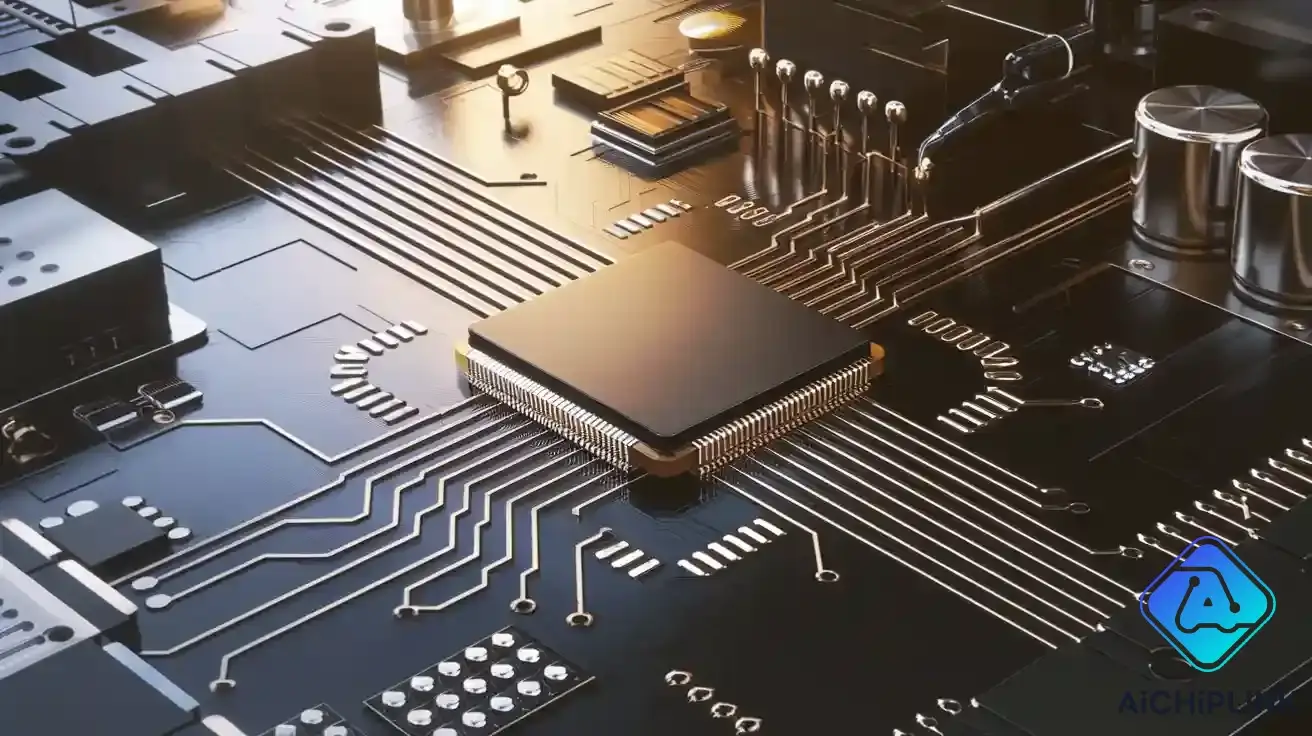
The next generation of industrial embedded boards brings better processing. These boards have strong connections and improved security. They work well in tough places. Manufacturers make these boards for hot and cold temperatures. They also last a long time and can handle rough use. This makes them different from boards made for regular people. Important new features include IIoT integration, edge computing, and protocol bridging.
The market for industrial embedded boards was about USD 11.5 billion in 2023. It may grow to USD 20.4 billion by 2032. This shows a 6.7% CAGR.
| Metric | Value/Range | Notes |
|---|---|---|
| Market Size 2023 | USD 11.5 billion | Embedded computer boards and modules market |
| Projected Market Size 2032 | USD 20.4 billion | Growth trajectory |
| Compound Annual Growth Rate | 6.7% | Indicates increasing adoption rate |
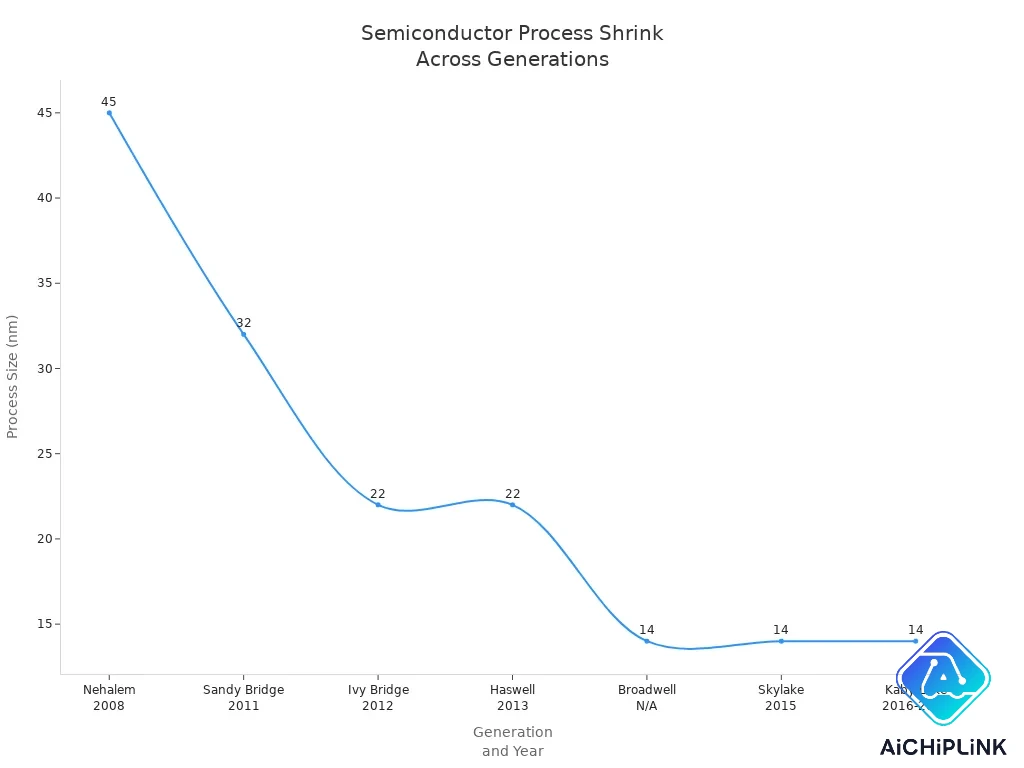
Key Takeaways
- Next-generation industrial embedded boards are made strong. They can work in places with very hot or cold weather. They also work well where there is a lot of dust or shaking. These boards have fast processors and AI features. They help factories work smarter. They let factories make quick choices right where the work happens. The boards can connect to many machines and networks. This makes it easy to add new parts or link old and new systems. The boards are made to last a long time. They have strong security to keep them safe and working well for years. This helps save money and stops long breaks in work. More people are buying these boards now. This is because many industries use automation, AI, and digital changes all over the world.
Next Generation Overview
Key Advancements
Next generation industrial embedded boards bring many new improvements. These changes help factories work better and more reliably. Some of the main advancements are:
-
Real-time data processing at the edge helps make decisions faster.
-
AI accelerators like GPUs, NPUs, and FPGAs allow smart tasks. These tasks include finding defects, predicting problems, and checking quality.
-
Rugged and scalable designs keep boards working in tough places. They can handle hot and cold, shocks, and shaking.
-
Boards support many industrial protocols and have lots of I/O options. This lets them connect to different sensors and devices easily.
-
Modular designs and containerization make boards easy to upgrade. They can be used in many factories and for different jobs.
-
Embedded AI features mean boards do not need the cloud as much. This keeps data private, improves uptime, and helps processes change quickly.
-
Multicore CPUs and real-time operating systems help boards work on time. This is important for automation and time-sensitive jobs.
-
Security features like secure boot, hardware root of trust, and TPM keep boards safe from cyber attacks.
-
Energy-efficient designs use less power but still work fast. This saves money on running costs.
-
Boards have many ways to communicate, like Wi-Fi, Bluetooth, Ethernet, and GNSS. This helps share data quickly and reliably.
-
Built-in sensors, Real-Time Clock, and watchdog features keep systems stable in important situations.
Note: MiTAC’s PH12ARI and E430-12ARI, and ADLINK’s Matrix and NISE 53, show these new features. They have strong processors, built-in AI, and tough builds.
Core Purpose
The main goal of next generation boards is to make factories smarter and more efficient. These boards help bring digital changes to manufacturing and other industries. Their main jobs are:
-
Making factories better with predictive maintenance, automation, and quality checks.
-
Using edge AI for quick problem spotting, managing inventory, and improving processes on the device.
-
Being tough and able to work in hard places.
-
Giving strong computing power with advanced CPUs and GPUs for AI and machine vision.
-
Offering better connections, security, and ways to grow for changing needs.
-
Acting as the main computer that helps with speed, accuracy, uptime, and smart choices at the edge.
Industrial embedded boards help companies work faster, avoid downtime, and change quickly when needed. Their strong build and smart features make them very important for today’s factories.
Industrial Embedded Boards Features
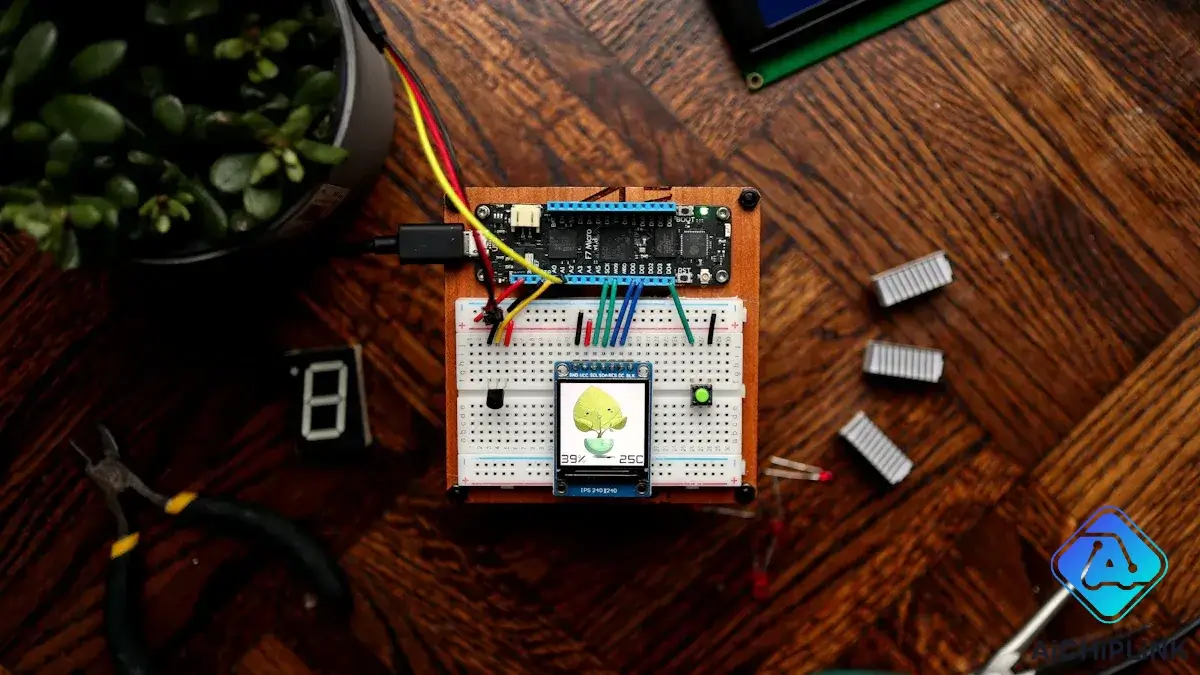
Rugged Design
Next-generation industrial embedded boards are built to be very tough. They work well in places that are dirty, hot, or cold. Fanless cooling keeps dust and dirt out, so the boards can run all day and night. New processors like the 11th and 13th Generation Intel Core i series make these boards fast and strong. The cases protect the boards from heat, cold, shaking, drops, water, and dust. Some boards have high IP ratings, like IP69K and NEMA 4x, so they can be used in wet or dusty places. You can put these boards on a DIN rail or a wall, which helps in small spaces.
| Feature Category | Evidence from Next-Generation Industrial Embedded Boards |
|---|---|
| Cooling System | Fanless design reduces dust and debris ingress, enabling 24/7 continuous operation in harsh environments. |
| Processors | Use of advanced processors such as 11th and 13th Generation Intel Core i series and Intel Celeron processors enhances performance and ruggedness. |
| Enclosure Durability | Rugged enclosures withstand wide temperature ranges, vibration, drops, dust, and water exposure; IP ratings up to IP69K and NEMA 4x waterproof. |
| Mounting Options | Versatile mounting options including DIN rail, wall mounts, and compact form factors for space-constrained environments. |
| Security and Expansion | Integration of TPM 2.0 security, PCIe expansion slots, and support for Windows 11 for modern capabilities within rugged designs. |
| Specialized Models | Hazardous location computers with C1D2 ratings for explosive environments; rugged AI platform PCs with PCIe expansions and fanless design. |
Industrial embedded boards must pass hard tests to prove they are strong. For example, Advantech boards pass vibration tests that follow IEC60068-2-64 and MIL-STD-202G rules. The IBASE AGS102 IoT Gateway meets IEC60068-2-64 and MIL-STD-810G, so it can handle hard hits and shaking. These tests show the boards will work well during shipping and in tough places.
High Performance
Industrial embedded boards are made to be very powerful. They use new processors like the 14th Gen Intel Core. These boards can use AI with GPUs and NPUs. They are great at handling real-time data, machine vision, and edge AI jobs.
| Performance Metric | Benchmark Name(s) | Description / Relevance |
|---|---|---|
| CPU Performance | x11perf, dcraw | Evaluates CPU speed in embedded systems. |
| GPU Performance | SHOC | Measures GPU computing for vision and deep learning. |
| Memory Bandwidth | stream, cl-mem | Assesses memory throughput, vital for image processing and GPU tasks. |
| Heterogeneous Compute | ADASMark, MLMark | Tests performance for automotive ADAS and machine learning inference. |
| Single-core Performance | CoreMark, AutoBench | Compares processor core speed for industrial and automotive uses. |
| Multi-core Performance | CoreMark-Pro, AutoBench-2.0 | Measures parallel processing capabilities. |
| Floating-point | FPMark | Focuses on floating-point workloads for complex calculations. |
| Application-specific | DENBench, Networking, OABench, TeleBench | Targets entertainment, networking, office, and telecom performance. |
These tests show that next-generation boards can do hard jobs quickly. High memory bandwidth, like 320 GBit/sec from Nvidia GTX 1080 GPUs, lets them move lots of data fast. This helps the boards finish AI and vision tasks quickly and correctly.
Connectivity Options
Modern industrial embedded boards have many ways to connect to other devices. They have several serial ports, CAN bus, and more than one Gigabit Ethernet port, even 2.5G. New wireless options like 5G and Wi-Fi 6 give fast and steady connections. Strong M12 connectors keep cables safe in places with shaking or water. Expansion slots like M.2 and mini-PCIe let you add AI chips, storage, or sensors.
| Connectivity Feature | Next-Generation Industrial Boards | Raspberry Pi |
|---|---|---|
| Serial Ports | RS-232/422/485 (industrial-grade, isolated) | Limited or none |
| CAN Bus | Supported | Not supported |
| Ethernet | Multiple Gigabit Ethernet ports, including 2.5G | Single Gigabit Ethernet |
| Wireless Connectivity | 5G, Wi-Fi 6 | Wi-Fi 5 or optional external modules |
| Expandable Interfaces | M.2, mini-PCIe slots for AI accelerators, storage, sensors | Fixed architecture, limited expandability |
| Connectors | Ruggedized M12 connectors for harsh environments | Standard consumer-grade connectors |
| Isolation and Protection | Isolated serial ports to protect against voltage spikes | No isolation |
| Modularity and Scalability | Supports legacy and modern industrial protocols and wireless standards | Limited protocol support |
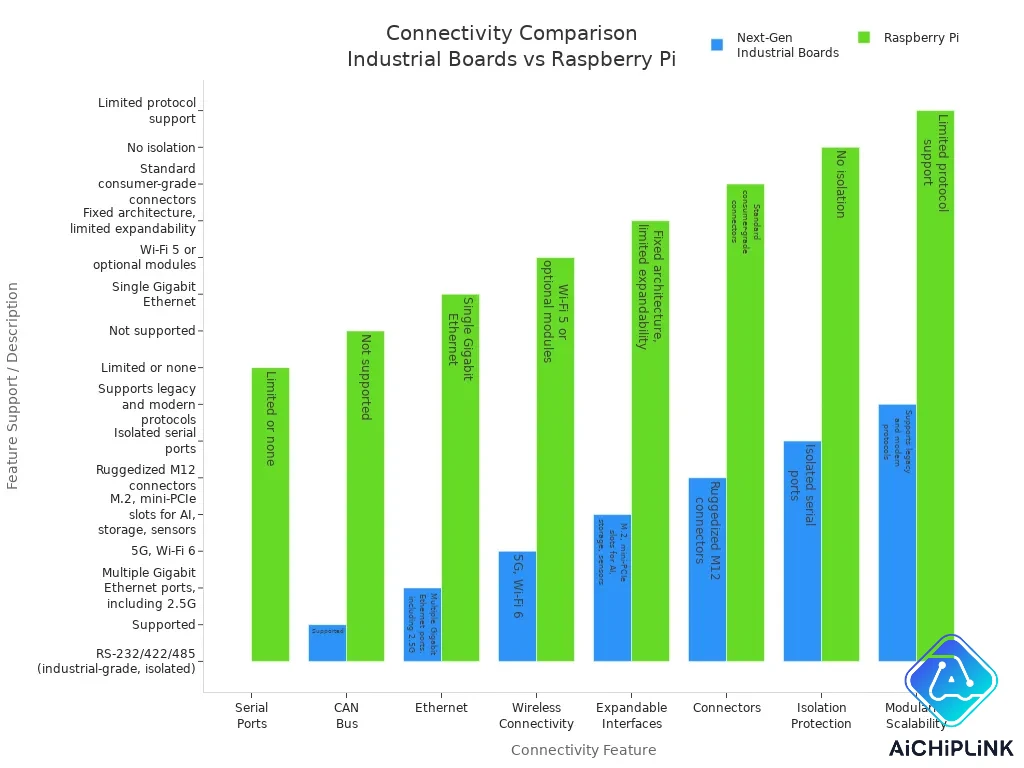
These features help the boards work with old machines and new IoT networks. The boards are easy to upgrade, so they can last a long time.
Long Lifecycle
Industrial embedded boards are made to last a long time in hard places. Makers use strong materials and smart designs to keep them working. Fanless, IP65-rated panel PCs can work in hot or cold and can be changed for different jobs. Rugged tablets with MIL-STD-810H and IP66 ratings can handle water, dust, and drops. Edge servers and box PCs can run all day, every day. Locking bezels, intrusion detection, and port blocking keep the boards safe and steady.
-
These boards use new processors like Intel Core Ultra and 14th Gen Intel CPUs for new jobs.
-
Modular and simple designs make upgrades and repairs easy.
-
Smart firmware, like self-healing and sensors, helps the boards last longer.
This focus on being tough and easy to upgrade means you do not need to buy new hardware often, which saves money.
Software and Security
Next-generation industrial embedded boards work with many types of hardware and software. They run on x86 and ARM 64-bit chips, including multi-core and AI-enabled SoCs. The software is modular, with middleware, OS services, and support for other systems. Safety certifications like ISO 26262 ASIL D and IEC 61508 SIL 3 make sure the boards are safe for important jobs.
| Aspect | Details |
|---|---|
| Hardware Compatibility | Supports x86 and ARM 64-bit platforms, multi-core CPUs, and AI-enabled SoCs. |
| Software Modularity | Modular foundational software, middleware, and OS services. |
| Safety Certifications | QNX OS for Safety certified to ISO 26262 ASIL D, IEC 61508 SIL 3, and more. |
| Hypervisor Support | QNX Hypervisor for Safety enables mixed-criticality, multi-OS environments. |
| Development Tools | Includes sample apps, open-source support, frameworks, containers, and board support packages. |
| Communication Protocols | Supports DDS, TSN, Profinet, Profisafe EtherCAT, CANOpen Safety, Modbus. |
| Security Features | Secure boot, encrypted code, runtime integrity verification, and IP protection. |
| Cybersecurity Compliance | Meets EU Cyber Resilience Act, ETSI EN 303 645, NIST, and IoT Cybersecurity Improvement Act. |
| Development Platform | Cloud-ready with CI/CD automation, remote collaboration, and integration with Kubernetes, Jenkins, GitHub, GitLab. |
| Code Quality Tools | Static and runtime code analysis, automated testing, debugging, and trace tools. |
Developers can use many programming languages and tools. C is used most for embedded software because it is fast and close to the hardware. C++ is good for big and complex systems. Rust is getting popular because it is safe and fast. Python, like MicroPython, is good for quick testing and simple logic. Frameworks like FreeRTOS, Zephyr, and embedded Linux help with real-time jobs and make hardware easier to use. These choices help developers balance speed, safety, and how fast they can work.
-
Modern C++ (C++17, C++20) makes code safer and easier to read.
-
Rust is safe for memory and good for important jobs.
-
Python/MicroPython is fast for testing and learning.
-
Frameworks like Arduino, Mbed OS, and Zephyr RTOS help build projects in parts.
-
Using both low-level and high-level languages gives the best mix of speed and easy coding.
This wide support helps people write better code and makes the boards ready for new needs.
Energy Efficiency
Energy efficiency is very important for new industrial embedded boards. Makers use processors like AMD’s 4th Gen EPYC, which are top for performance per watt in SPECpower_ssj2008 tests. These chips give lots of power but use less energy than older ones. The Arm Ethos-U85 NPU is 20% better than older models, so it can do edge AI jobs using less power. This helps the boards run longer and saves energy costs.
Energy-efficient boards help companies save money and meet green goals without losing speed.
Next Generation vs Previous Solutions
Durability
Next-generation industrial embedded boards are much tougher than before. Makers build these boards to work in rough places. The Neousys POC-700 stays cool and small because of smart design. The Neousys Nuvo-9160GC has special GPU brackets that stop shaking and bumps from causing problems. The POC-465AWP does not use a fan and is waterproof. It has a case made of stainless steel and aluminum. Its sealed case stops rust and works in very hot or cold weather, from -25°C to 70°C. The Arestech MERA-2000 is a strong box PC with many ports for factories.
-
Tiny controllers make CPUs faster and keep them cool.
-
Tough edge AI computers keep GPUs safe from shaking.
-
Fanless computers with IP66 ratings keep out water and rust.
-
Strong box PCs work well in factories.
| Embedded Board Type | Durability Features | Improvements Over Previous Solutions |
|---|---|---|
| nanoETXexpress Module | Smaller size, heat plates, cools by touching metal | Still tough, better at staying cool |
| ETX Modules | Heat plates, works in hot and cold | Lasts longer in rough places |
| CompactPCI (3U) | Very stiff, cools well | Handles bumps and shaking better |
| VME Boards | Works in many temperatures, proven to be tough | Good for factories and the military |
| PC/104 Boards | Strong plugs, can stack, cools without fans | Stronger, no moving parts |
| MicroTCA | Tough, cools by touching metal, cards held tight | Handles bumps and shaking better |
These features help the boards last longer and work better than old ones.
Scalability
Next-generation boards can grow and change more easily. Edge computers with AI can run machine learning right on the device. This helps fix problems before they happen and means less need for the cloud. RISC-V chips give more choices and do not lock you to one company. Developers get help from open-source tools and new ways to work like CI/CD and DevSecOps.
-
New ways to connect, like 5G LTE and Wi-Fi 6, help connect lots of devices.
-
Cloud links let you manage many boards, fix problems from far away, and update software over the air.
-
Raspberry Pi Hats make it easier to try new ideas.
-
AI chips on the board let it do smart tasks right away.
These changes make it simple to add more boards or change them for new jobs.
Support
Makers give better help and longer support for new boards. Some boards with Intel chips can be bought for up to 15 years. Companies keep the parts list the same and control changes to hardware and software. They tell customers 6-12 months before stopping a product and keep extra stock after that. Drawings with version control help keep designs the same.
| Category | Details |
|---|---|
| Lifecycle Management | Up to 15 years to buy, locked parts list, version control, early warnings, extra stock, design drawings |
| Technical Support | Customer help, returns, manuals, datasheets, drivers, FAQs |
-
Good planning helps when parts are no longer made.
-
Working with suppliers and watching plans keeps products around longer.
-
Last chance buys and keeping stock help avoid problems.
-
New parts are checked and tested fully.
-
Joining standards groups helps keep old and new boards working together.
Makers also give regular software updates, security fixes, and quick emergency patches. Services like Git access and working with Timesys help lower costs and keep boards safe.
Applications
Automation
Next-generation industrial embedded boards help automate factories and production lines. These boards power smart Human-Machine Interfaces, or HMIs. Operators can use touch, voice, or gestures to control machines. HMIs show updates and alerts right away. This helps workers act fast when needed. Embedded boards connect with industrial protocols and cloud services. This lets people watch machines from far away. In a plastic bottle factory, these systems change gear ratios and temperature. They also check how fast things move and look for broken products. The boards can find dangers like gas leaks and send warnings. All these features help make factories safer and reduce mistakes.
Embedded boards such as the VT-SBC-3399 can run many operating systems. They work well in tough places. Their fanless design and easy upgrades make them great for smart IoT, digital signs, and robots.
Edge AI
Industrial embedded boards let edge AI work by handling data close to where it is made. These boards run AI models like convolutional neural networks quickly and use little power. In farming, they help robots and drones spot sick plants very well. Boards look at sensor data to find problems early and help fix things before they break. This means less downtime. They also help with machine vision and sound sorting, making choices without sending data to the cloud. Special processors like NVIDIA Jetson modules are good at doing many jobs at once. Tough designs mean these boards can be used on farms and in factories.
-
Boards give fast AI answers and help make work better.
-
Processing data nearby keeps information private and speeds things up.
-
Example designs and software tools help developers build AI projects faster.
Smart Manufacturing
Smart manufacturing uses embedded boards to make work faster and better. For example, a phone company made its robots work better by using smart embedded boards. These boards use special math to cut down shaking and make robots move smoother. IoT sensors collect data for fixing machines before they break and for checking quality. Edge computing lets data be handled right on the shop floor, so answers come fast. Developers use platforms that can grow to add new apps quickly. Embedded gateways help watch over machines in tough places.
-
Automation, finding broken parts, and making supply chains better all use embedded boards.
-
Boards help factories use Industry 4.0 technology.
Other Industries
Industrial embedded boards are strong and can be used in many fields.
| Sector | Example Applications |
|---|---|
| Medical Imaging | Medical panel PCs, healthcare tablets, imaging monitors |
| Industrial Control | Mini-ITX motherboards, rugged computers, control systems |
| Digital Displays | Touchscreen monitors, sunlight-readable displays, panel mount monitors |
| Telecommunications | Smart kiosk modules, embedded box PCs, PoE computers |
| Flight Systems | Mission computers, certified rugged systems |
Boards work in very hot or cold places and keep out dust, water, and rust. Some designs, like Neousys's POC-465AWP, are waterproof and have safe I/O ports. Congatec's SMARC modules help with machine vision, robots, and 3D printing. ASRock Industrial's Mini-ITX motherboards are made for smart stores, travel, and city systems. Advantech's Thin Mini-ITX board is used in outdoor kiosks and medical tools. These boards are powerful, can be upgraded, and are small, so they fit many jobs.
-
Embedded systems help with medical imaging, digital signs, and telecom.
-
Boards let edge computing and AI work in flight systems and industrial control.
Next-generation embedded boards can change for new jobs and work well in hard places.
Future Trends
AI and Machine Learning
Next-generation industrial embedded boards can now use advanced AI and machine learning. Engineers use TinyML to run AI on microcontrollers that need very little power. Many boards have special AI co-processors or NPUs built into their chips. These parts help AI tasks go faster and cut down on waiting time. Edge-focused designs let devices handle data and make choices right where they are. This keeps information private and uses less network space. Developers use tools like TensorFlow Lite Micro and Edge Impulse to put AI models on small boards. Power-saving tricks, like turning off parts or using sleep modes, help boards run AI jobs well. AI helps with fixing machines before they break, finding problems, and making quick choices in factories. Hardware can be ARM Cortex-M microcontrollers, Google Coral Edge TPU, or FPGAs. Engineers must think about heat and small spaces when building boards for AI. They also deal with problems like not enough resources, needing things to happen fast, and keeping data safe.
Edge AI is growing quickly. Devices can now make choices without sending data to the cloud. This means sensors, robots, and machines are getting smarter in many fields.
Digital Transformation
Factories and other industries use embedded boards to help with digital change. These boards make factories better by helping with fixing machines before they break and making work automatic. They help factories work faster and stop less. Edge AI lets boards find problems and keep track of supplies right away. Boards can make choices on their own, so they do not need to wait for a main server. Tough, fanless computers with NVIDIA Jetson Orin modules give strong AI power in hard places. These boards help show data clearly and help teams talk better. Companies use these boards to speed up automation and make factories smarter.
-
Fixing machines before they break means less stopping.
-
Looking at data right away helps make better products.
-
Sharing data openly helps teams work together.
Market Growth
The market for new industrial embedded boards is getting bigger all over the world. Asia Pacific has the biggest share and is growing the fastest. North America and Europe are also growing a lot. The Middle East & Africa is growing the quickest. Industry 4.0, IoT, and AI are helping this market grow. The world market was USD 8.7 billion in 2023 and could reach USD 16.2 billion by 2033.
| Region | Market Size 2023 (USD Billion) | Market Size 2033 (USD Billion) | CAGR (2024–2033) |
|---|---|---|---|
| Asia Pacific | 3.1 | 6.1 | 6.1% |
| North America | 2.6 | 5.4 | 7.4% |
| Europe | 1.5 | 3.1 | 6.8% |
| Latin America | 0.45 | 1.0 | 7.1% |
| Middle East & Africa | 0.15 | 0.6 | 8.3% |
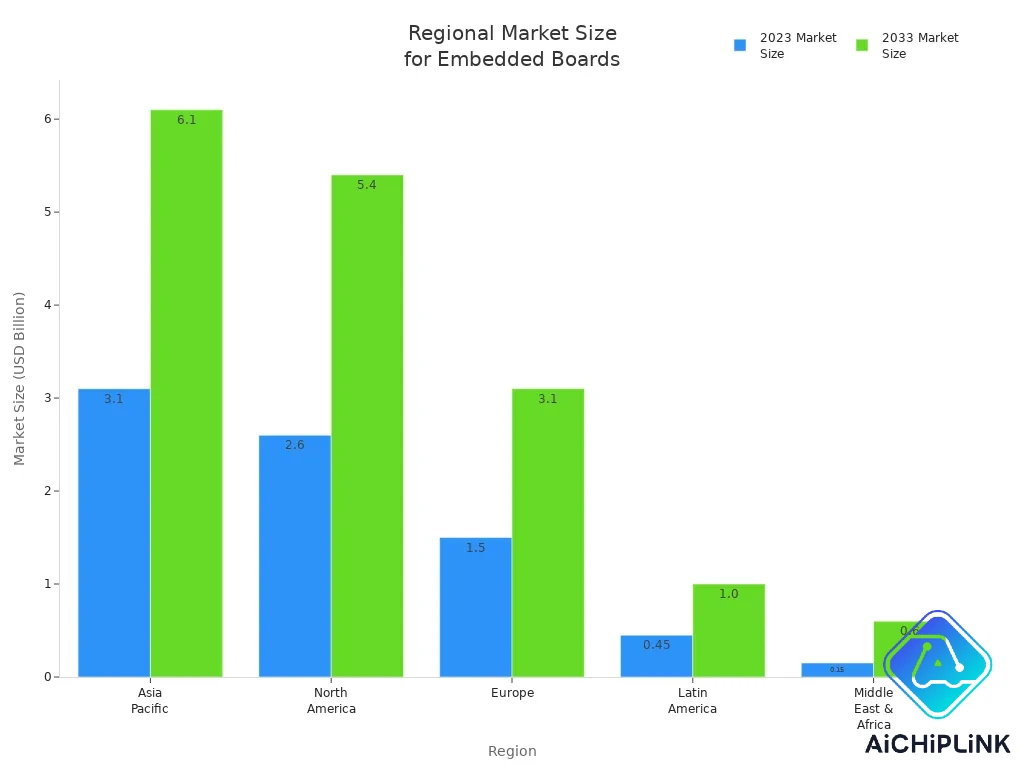
Automotive embedded boards will grow a lot, from USD 2.5 billion in 2024 to USD 4.8 billion by 2033. More electric cars, self-driving features, and better safety will make more people use these boards. New things like AI accelerators and neuromorphic chips will change how industrial embedded boards work in the future.
Next-generation industrial embedded boards are very useful for Industry 4.0. They are tough, use smart AI, and work well for a long time. These boards can handle real-time data and help fix machines before they break. They also make factories more automatic and smart. Some important features are:
-
They follow strict rules in the U.S. and other countries for safety and being green
-
The hardware is small, strong, and works in rough places
-
They have fast edge computing and use AI for smart jobs
-
They last a long time and can change as needs grow
When companies use these boards, they work better, spend less money, and are ready for the future.
FAQ
What makes next-generation industrial embedded boards different from consumer boards?
Next-generation industrial embedded boards are built to be tough. They use strong designs and advanced processors. These boards last a long time and work in hard places. They have better security than consumer boards. Consumer boards are made for regular use and lower cost. Industrial boards must follow strict rules for safety and reliability.
Which industries benefit most from these boards?
Many industries use these boards, like manufacturing and healthcare. Transportation and telecommunications also gain a lot. These boards help with automation and edge AI. They control things in real time. They work well in smart factories and medical imaging. Mission-critical systems also use them.
How do these boards ensure long-term reliability?
Makers use strong materials to build these boards. They test them for shock and vibration. Boards are checked for very hot and cold temperatures. Companies get long-term support and regular updates. Strict version control helps keep boards working well. This means fewer replacements are needed.
What programming languages do developers use for these boards?
Developers use C, C++, and Rust for speed and safety. Python and MicroPython help make quick tests. Many boards work with Zephyr and FreeRTOS. Embedded Linux is also supported for flexible projects.
Are next-generation industrial embedded boards energy efficient?
Yes, these boards save energy. They use new processors that need less power. Features like sleep modes help lower costs. Efficient AI accelerators also save energy. Companies can meet green goals and keep good performance.

Written by Jack Elliott from AIChipLink.
AIChipLink, one of the fastest-growing global independent electronic components distributors in the world, offers millions of products from thousands of manufacturers, and many of our in-stock parts is available to ship same day.
We mainly source and distribute integrated circuit (IC) products of brands such as Broadcom, Microchip, Texas Instruments, Infineon, NXP, Analog Devices, Qualcomm, Intel, etc., which are widely used in communication & network, telecom, industrial control, new energy and automotive electronics.
Empowered by AI, Linked to the Future. Get started on AIChipLink.com and submit your RFQ online today!














